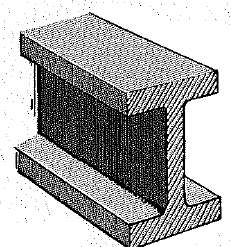
Concept explainers
Why is the cross section of a metal beam I-shaped and not rectangular?

To Explain: The cross section of metal beam is I-shaped and not rectangular.
Explanation of Solution
Introduction:
In rectangular beam, more steel material is used which increases the weight of the beam. To reduce the weight of the beam, it is I-shaped.
The beam’s material is scooped from the middle. Least material is put at middle so that beam becomes I-shaped. I-shaped beam becomes light in weight but carries the same strength as that of a rectangular beam.
Conclusion:
I-shaped beams are light in weight and carry the same strength of the rectangular beam.
Chapter 18 Solutions
Conceptual Physics: The High School Physics Program
Additional Science Textbook Solutions
Human Physiology: An Integrated Approach (8th Edition)
Human Biology: Concepts and Current Issues (8th Edition)
Chemistry: Structure and Properties (2nd Edition)
Campbell Essential Biology with Physiology (5th Edition)
Microbiology: An Introduction
Genetic Analysis: An Integrated Approach (3rd Edition)
- ! Required information The radius of the Moon is 1.737 Mm and the distance between Earth and the Moon is 384.5 Mm. The intensity of the moonlight incident on her eye is 0.0220 W/m². What is the intensity incident on her retina if the diameter of her pupil is 6.54 mm and the diameter of her eye is 1.94 cm? W/m²arrow_forwardRequired information An object is placed 20.0 cm from a converging lens with focal length 15.0 cm (see the figure, not drawn to scale). A concave mirror with focal length 10.0 cm is located 76.5 cm to the right of the lens. Light goes through the lens, reflects from the mirror, and passes through the lens again, forming a final image. Converging lens Object Concave mirror 15.0 cm -20.0 cm- 10.0 cm d cm d = 76.5. What is the location of the final image? cm to the left of the lensarrow_forward! Required information A man requires reading glasses with +2.15-D refractive power to read a book held 40.0 cm away with a relaxed eye. Assume the glasses are 1.90 cm from his eyes. His uncorrected near point is 1.00 m. If one of the lenses is the one for distance vision, what should the refractive power of the other lens (for close-up vision) in his bifocals be to give him clear vision from 25.0 cm to infinity? 2.98 Darrow_forward
- ! Required information Assume that the magnifier is held close to the eye. Use the standard near point of 25.0 cm to find the angular magnification. An insect that is 4.10 mm long is placed 10.3 cm from a simple magnifier with a focal length of 13.0 cm. What is the angular magnification?arrow_forward2arrow_forward3arrow_forward
- Imagine you are out for a stroll on a sunny day when you encounter a lake. Unpolarized light from the sun is reflected off the lake into your eyes. However, you notice when you put on your vertically polarized sunglasses, the light reflected off the lake no longer reaches your eyes. What is the angle between the unpolarized light and the surface of the water, in degrees, measured from the horizontal? You may assume the index of refraction of air is nair=1 and the index of refraction of water is nwater=1.33 . Round your answer to three significant figures. Just enter the number, nothing else.arrow_forwardDeduce what overvoltage is like in reversible electrodes.arrow_forwardpls help on thesearrow_forward
- pls help on thesearrow_forward20. Two small conducting spheres are placed on top of insulating pads. The 3.7 × 10-10 C sphere is fixed whie the 3.0 × 107 C sphere, initially at rest, is free to move. The mass of each sphere is 0.09 kg. If the spheres are initially 0.10 m apart, how fast will the sphere be moving when they are 1.5 m apart?arrow_forwardpls help on allarrow_forward
 College PhysicsPhysicsISBN:9781305952300Author:Raymond A. Serway, Chris VuillePublisher:Cengage Learning
College PhysicsPhysicsISBN:9781305952300Author:Raymond A. Serway, Chris VuillePublisher:Cengage Learning University Physics (14th Edition)PhysicsISBN:9780133969290Author:Hugh D. Young, Roger A. FreedmanPublisher:PEARSON
University Physics (14th Edition)PhysicsISBN:9780133969290Author:Hugh D. Young, Roger A. FreedmanPublisher:PEARSON Introduction To Quantum MechanicsPhysicsISBN:9781107189638Author:Griffiths, David J., Schroeter, Darrell F.Publisher:Cambridge University Press
Introduction To Quantum MechanicsPhysicsISBN:9781107189638Author:Griffiths, David J., Schroeter, Darrell F.Publisher:Cambridge University Press Physics for Scientists and EngineersPhysicsISBN:9781337553278Author:Raymond A. Serway, John W. JewettPublisher:Cengage Learning
Physics for Scientists and EngineersPhysicsISBN:9781337553278Author:Raymond A. Serway, John W. JewettPublisher:Cengage Learning Lecture- Tutorials for Introductory AstronomyPhysicsISBN:9780321820464Author:Edward E. Prather, Tim P. Slater, Jeff P. Adams, Gina BrissendenPublisher:Addison-Wesley
Lecture- Tutorials for Introductory AstronomyPhysicsISBN:9780321820464Author:Edward E. Prather, Tim P. Slater, Jeff P. Adams, Gina BrissendenPublisher:Addison-Wesley College Physics: A Strategic Approach (4th Editio...PhysicsISBN:9780134609034Author:Randall D. Knight (Professor Emeritus), Brian Jones, Stuart FieldPublisher:PEARSON
College Physics: A Strategic Approach (4th Editio...PhysicsISBN:9780134609034Author:Randall D. Knight (Professor Emeritus), Brian Jones, Stuart FieldPublisher:PEARSON





